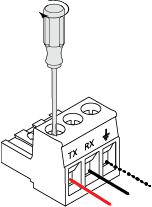
Pinout
- TX (Transmit)
- RX (Receive)
- GND (Signal Ground)
You must check the pinout of any equipment, including the cable, to be connected to a Q-SYS serial port for input or output. Many times in serial troubleshooting, problems may be solved by inserting a "null-modem" adapter or cable to swap the TX and RX pin positions. The TX pin on one end MUST be connected to an RX pin on the other and vise-verse for data to flow properly.
